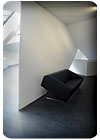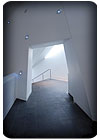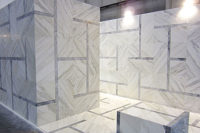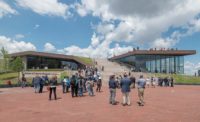
Photos by Jason Hayes Photography / Boulder, CO
Located at the base of the majestic Rocky Mountains in Denver, CO, is a thriving mecca of music, art, activity and culture. Blessed with 300 days of sunshine a year, rugged terrain, lakes and rivers, few if any metropolitan areas have a stronger connection to nature than the “Mile High City.” This cultural awareness and passion for the arts led to a need to expand the 113-year-old Denver Art Museum, which was originally designed by Italian architect Gio Ponti in 1893. And for the interior flooring throughout the new Frederic C. Hamilton building, Black Pearl granite was chosen for its sleek look and durability.
To realize the delicate expansion of this urban museum, Daniel Libeskind, best known as the architect chosen to resurrect Ground Zero - site of the attacks on the World Trade Center in the heart of New York City - was chosen by a 12-member selection committee to work in collaboration with the Denver-based architectural firm Davis Partnership. Inspired by the geology of the Rockies, Libeskind’s vision was not to create a stand-alone building, but rather one that would take its place as part of a composition of public spaces, monuments and gateways that already existed in the downtown area, according to a statement released by the architect.
“Nexus is conceived in close connection with the function and aesthetic of the existing Ponti Museum, as well as the entire Civic Center and public library,” stated Libeskind. “The new building is a Nexus tying together downtown and Civic Center, forming a strong composition to the golden triangle neighborhood.”
Construction of this new wing, considered by some critics to be the most unusual and unique building project to take place in the U.S. in the last four decades, took over three years to complete, with over 200 people a day working on different parts of the building. The process required more than 2,750 tons of steel, including 9,000 panels of titanium cladding and over 50,000 bolts. The unconventional and modern interior design resulted in sloped walls with no right angles to carry the weight of the building, meaning no plumb staircases or floor lines either, which greatly challenged every trade involved in the process. Measurements and calculations had to be extremely precise, and even what would normally be considered routine processes, such as building scaffoldings to access the walls and frames of the four-story wing, became troublesome and time consuming with the angles that were presented in the design.
“One of the challenges of building the Denver Art Museum was to work closely and respond to the extraordinary range of transformations in light, coloration, atmospheric effects, temperature and weather conditions unique to the City,” stated the architect.

Stone selection
The stone selected for the floor of this new-age museum was meant to be subtle, so as to not distract from the contemporary and modern art that it showcases. For this reason, smooth Black Pearl granite was chosen. “The materials of the building closely relate to the existing context (local stone) as well as innovative new materials (titanium), which together will form spaces that connect local Denver tradition to the 21st Century,” stated Libeskind.A stone-setting system from Laticrete International, Inc. of Bethany, CT, was implemented for the installation, which was completed by Ryan and Company, Inc. - an experienced and skilled stone installer in the Rocky Mountain region. Ryan and Company, originally hired as a consultant for the project in the design phase, ultimately won the bid due to the experience the firm’s owner, Pat Ryan, has with high-profile commercial stone installations in the area, such as the Colorado Convention Center expansion, the Wellington E. Webb Municipal Building and the Denver Convention Hotel.
“Due to the complexities of the building and all of the calculations that had to be done, it was hard to get a handle on this project,” said Ryan. “We had 1,600 feet of linear treads and risers that had to go up all four stories. We had to float all the steel and make sure that the risers were clean, so from that standpoint, it was very challenging. With all the complexities involved, every trade was behind [schedule], and the building ended up being finished 10 months behind schedule. That added even more pressure, since there were a lot of investors involved and condos that were part of the site-on-site package of the courtyard waiting to be opened.”
Ryan, who personally traveled to China himself to purchase the Black Pearl granite, installed the 40,000 square feet of recessed pieces with Laticrete’s products in a non-bonded, wire-reinforced mortar bed using the Tile Council of North America’s method F111 for stone over concrete.

The installation process
Given the circumstances - the job was too large to pour the concrete in one day; the threat of seismic movement in a mountainous area; and concrete’s inherent nature to shrink as it cures - Ryan and Company used Laticrete® Blue 92 Anti-Fracture Membrane on all cold and expansion joints. To avoid the problem of stone installations cracking due to failure in the concrete substrate below, Blue 92 is TCNA Extra Heavy rated per ASTM C627, allowing for successful installations even on the most high-traffic applications such as the museum, which draws over 435,000 visitors annually.To protect against moisture in the wet areas of the Denver Art Museum, Ryan and Company used Laticrete® 9235 Waterproofing Membrane. Additionally, to set and level the recessed slabs of Black Pearl granite, Laticrete® 253 Gold Multipurpose Thin-Set Mortar was evenly distributed to ensure maximum bond.
After the substrate was prepared, and the recessed pieces set in a mortar bed, Ryan and Company then grouted all the floors and staircases of the new expansion to the Denver Art Museum. With no plumb walls inside the Frederic C. Hamilton building, an intricate pattern of granite was to be grouted at a 103-degree angle. To accomplish this ambitious layout, the slabs were cut in four different sizes - 12 x 9, 12 x 6, 12 x 12 and 12 x 18 inches - and placed in a random linear pattern that repeated itself every 20 feet. For the final step, Ryan and Company chose Laticrete® 1500 Series Tri-Poly Fortified Sanded Grout to create a hard, dense and durable joint.
“This was a fantastic project,” said Ryan. “Architecturally speaking, it is a very unique building. The designs led to some radical stairways that were complex with regard to riser heights and mortar sets. With each course, we had to go up and over 3 inches following the slope of the wall. It is hard to really explain this project to anyone who hasn’t seen it. You almost have to come out and visit to be able to believe it. Just seeing this building is an emotional event in itself.”
“The new building is not based on an idea of style or the rehashing of ready made ideas or external shape because its architecture does not separate the inside from the outside or provide a pretty facade behind which a typical experience exists; rather this architecture has an organic connection to the public at large and to those aspects of experience that are also intellectual, emotional and sensual,” stated Libeskind.

